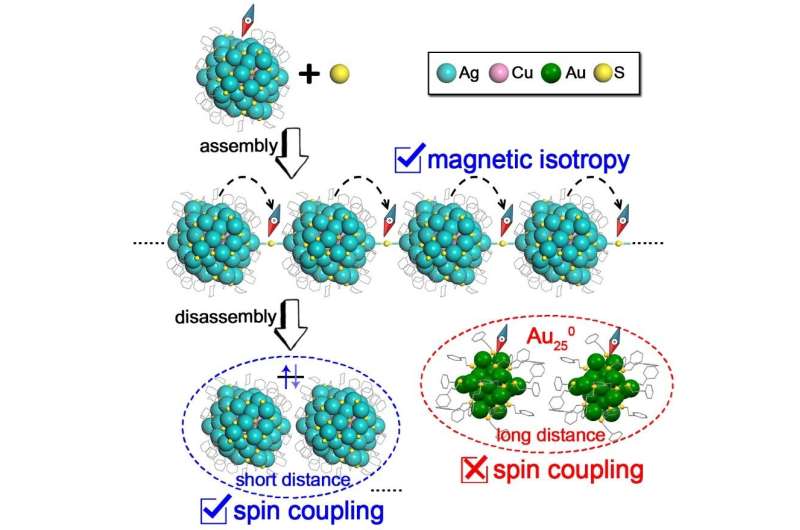Spin transfer and distance-dependent spin coupling in linearly assembled Ag-Cu nanoclusters

In a recent study published in Nature Communications, a research team led by Prof. Wu Zhikun from the Hefei Institutes of Physical Science (HFIPS) of the Chinese Academy of Sciences discovered spin transfer and spin coupling through the linear assembly of silver-copper (Ag-Cu) alloy nanoclusters with sulfur.
The assembly of metal nanoparticles not only enriches their properties, but also helps to understand structure-property relationships and interactions between nanoparticles. However, due to the multi-distribution of metal nanocrystals, it is difficult to obtain atomically precise assembly structures.
The recently emerging nanoclusters (ultrasmall nanoparticles) provide ideal building blocks for precise assembly due to their well-defined compositions and structures; however, few studies on atomically precise metal nanocluster (larger than 1 nm) assembly have been reported owing to the difficulty in synthesis and characterization.
In this study, the team prepared a linear assembly structure formed by linking two Ag77Cu22 clusters with one sulfur ion using a simultaneous synthesis and assembly strategy. The sulfur ions can be produced by the cleavage of carbon-sulfur and sulfur-hydrogen bonds of the thiols during the synthesis of the clusters, leading to the immediate link with clusters to form the assemblies.
Further studies showed that the magnetic moment in this linear assembled structure was transferred from the cluster to the sulfur, forming paramagnetic sulfur radicals, which exhibited magnetic isotropy due to the small spin-orbit coupling constants of sulfur and the absence of magnetic moment interaction between distant sulfur radicals.
When the linear structures were disassembled in solution, the magnetic moment transferred back to the clusters, and subsequently spin coupling occurred. Notably, such spin coupling had not been reported in the magnetic Au250 clusters, which was interpreted by the interparticle distance dependent spin coupling.
And when the ligands were flexible and their lengths were short, the clusters could approach each other and the spin coupling occurred within a certain distance. Otherwise, it was difficult for the clusters to come close for coupling.
This work achieves the linear assembly of the metal nanoclusters larger than 1 nm by using the adequate assembly strategy. It discovers and explains the spin transfer and distance-dependent spin coupling, which could have important implications for the future study of nanocluster magnetism and development of novel functional materials.
More information:
Nan Xia et al, Assembly-induced spin transfer and distance-dependent spin coupling in atomically precise AgCu nanoclusters, Nature Communications (2022). DOI: 10.1038/s41467-022-33651-9
Citation:
Spin transfer and distance-dependent spin coupling in linearly assembled Ag-Cu nanoclusters (2022, November 3)
retrieved 3 November 2022
from https://phys.org/news/2022-11-distance-dependent-coupling-linearly-ag-cu-nanoclusters.html
This document is subject to copyright. Apart from any fair dealing for the purpose of private study or research, no
part may be reproduced without the written permission. The content is provided for information purposes only.
For all the latest Science News Click Here
For the latest news and updates, follow us on Google News.

